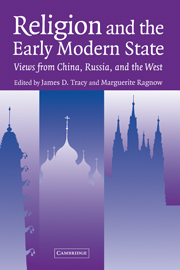Book contents
- Frontmatter
- Contents
- Contributors
- Acknowledgments
- Preface
- Religion and the Early Modern State
- Introduction
- PART I LIVED RELIGION AND OFFICIAL RELIGION
- PART II FORMS OF RELIGIOUS IDENTITY
- PART III THE SOCIAL ARTICULATION OF BELIEF
- 9 False Miracles and Unattested Dead Bodies: Investigations into Popular Cults in Early Modern Russia
- 10 Liturgical Rites: The Medium, the Message, the Messenger, and the Misunderstanding
- 11 Self-correction and Social Change in the Spanish Counter-Reformation
- 12 The Disenchantment of Space: Salle Church and the Reformation
- AN EPILOGUE AT THE PARISH LEVEL
- Selected Annotated Bibliography of Secondary Works
- Index
11 - Self-correction and Social Change in the Spanish Counter-Reformation
Published online by Cambridge University Press: 23 May 2010
- Frontmatter
- Contents
- Contributors
- Acknowledgments
- Preface
- Religion and the Early Modern State
- Introduction
- PART I LIVED RELIGION AND OFFICIAL RELIGION
- PART II FORMS OF RELIGIOUS IDENTITY
- PART III THE SOCIAL ARTICULATION OF BELIEF
- 9 False Miracles and Unattested Dead Bodies: Investigations into Popular Cults in Early Modern Russia
- 10 Liturgical Rites: The Medium, the Message, the Messenger, and the Misunderstanding
- 11 Self-correction and Social Change in the Spanish Counter-Reformation
- 12 The Disenchantment of Space: Salle Church and the Reformation
- AN EPILOGUE AT THE PARISH LEVEL
- Selected Annotated Bibliography of Secondary Works
- Index
Summary
The Counter-Reformation was for Spain, as it was for other European countries, a great watershed, a time when longstanding beliefs and behaviors usually characterized as traditional or medieval were discarded in favor of new ones. Official changes in religious ideas were made carefully, for early modern theologians and rulers fully understood both religion's integrative and disintegrative power. They saw the intimate connection between formal theology and social dealings, and if they embarked on the perilous course of changing religious law, they also expected concomitant change in society. Early modern people intuitively understood Clifford Geertz's conclusion that culture does not consist of a catalog of gestures per se but of the meanings that give gestures their significance, hence their willingness to fight (endlessly, it seems to us) over the religious laws and symbols, both humble and exalted, that gave meaning to their lives.
Both Reformations are distinguished by their self-conscious efforts to direct the beliefs and actions of entire populations or, to put it another way, their attempt to ensure cultural conformity through the shared understanding of symbols of faith. No transformation of cultural attitudes had been attempted on this scale in Europe since the original conversion of the Germanic tribes in the early Middle Ages, which took place under vastly different circumstances. This early modern battle for symbols and souls was waged on several fronts, through religious education, propaganda, and social discipline.
- Type
- Chapter
- Information
- Religion and the Early Modern StateViews from China, Russia, and the West, pp. 302 - 323Publisher: Cambridge University PressPrint publication year: 2004



